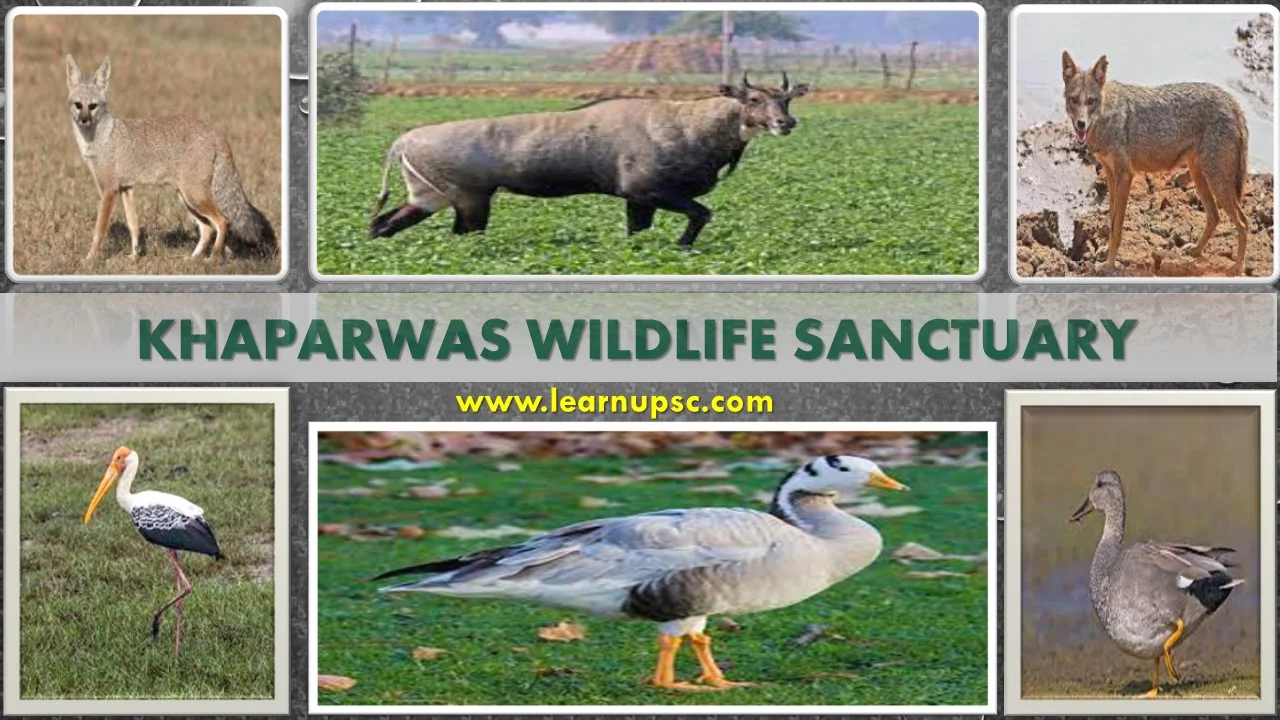Khaparwas Wildlife Sanctuary UPSC
The Khaparwas Wildlife Sanctuary is located in the state of Haryana, India. It is known for its rich biodiversity, particularly its avian population.
Khaparwas Wildlife Sanctuary is renowned for being a habitat for various bird species, both resident and migratory. It supports a wide range of avifauna, including waterfowl, waders, raptors, and passerine birds.
The sanctuary is part of an ecological corridor along the Sahibi River, which facilitates the movement of wildlife and helps maintain connectivity between different habitats.
|
Table of Contents
|
Khaparwas Wildlife Sanctuary Location
The Khaparwas Wildlife Sanctuary is located in the Jhajjar district of Haryana, India. The adjacent villages to the Khaparwas Wildlife Sanctuary are Khaparwas, Bhindawas, Chandol, Dhakla, and Surehti.
It is situated about 80 kilometers (50 miles) west of Delhi. The sanctuary lies 5 kilometers northwest of the Bhindawas Bird Sanctuary and 46 kilometers northwest of Sultanpur National Park via road.
Nearest Airport:
The Indira Gandhi International Airport in Delhi is the closest major airport to the Khaparwas Wildlife Sanctuary. It is approximately 80 kilometers (50 miles) east of the sanctuary.
Nearest Railway Station:
The Bahadurgarh Railway Station is one of the nearest railway stations to the Khaparwas Wildlife Sanctuary. It is located in the town of Bahadurgarh, which is about 30 kilometers (18.6 miles) east of the sanctuary.
Khaparwas Wildlife Sanctuary History
On January 30, 1987, the Forests Department of the Government of Haryana officially declared the Khaparwas Wildlife Sanctuary as a protected area. This designation aimed to provide a safe habitat for various wildlife species, particularly birds, and to conserve the natural ecosystems present in the region.
Khaparwas Wildlife Sanctuary Area
The Khaparwas Wildlife Sanctuary covers an area of approximately 82.70 hectares. The sanctuary's relatively small size reflects its role in providing a specific habitat for wildlife and contributing to the broader ecological corridor in the region.
Khaparwas Wildlife Sanctuary River
The Khaparwas Wildlife Sanctuary is an important part of the ecological corridor along the route of the Sahibi River. The Sahibi River traverses from the Aravalli hills in Rajasthan to the Yamuna River via various conservation areas, including the Khaparwas Wildlife Sanctuary.
The presence of the Sahibi River contributes to the availability of water sources within the sanctuary, supporting the diverse wildlife and bird species that inhabit the area.
Khaparwas Wildlife Sanctuary Flora
(1) Deciduous Forests:
These forests are characterized by trees that shed their leaves during certain seasons. They include species like neem, sal, babul and jamun (Syzygium cumini).
(2) Grasslands:
Grasslands are open areas dominated by various grass species. They provide grazing habitats for herbivores and nesting sites for ground-nesting birds. Common grass species include Cenchrus ciliaris (buffel grass) and Dichanthium annulatum (wagga grass).
(3) Aquatic and Wetland Plants:
You can find aquatic and wetland plants like lotus (Nelumbo nucifera), water lilies (Nymphaea spp.), and various reeds and rushes.
(4) Shrubs and Understory Plants:
Shrubs and understory plants provide cover and food sources for various wildlife. Species such as berberis (Berberis spp.), jatropha (Jatropha curcas), and Indian gooseberry (Emblica officinalis) could be present.
(5) Riparian Vegetation:
Along water bodies, you can find riparian vegetation, including species like banyan (Ficus benghalensis), peepal (Ficus religiosa), and various other trees and shrubs that thrive in wetter conditions.
Khaparwas Wildlife Sanctuary Fauna (Khaparwas Wildlife Sanctuary Animals)
The Khaparwas Wildlife Sanctuary is home to a variety of fauna, including both resident and migratory species.
Mammals:
- Nilgai
- Indian Fox
- Jackal
- Indian Hare
- Indian Gray Mongoose
Birds:
- Bar Headed Goose
- Greylag Goose
- Indian Cormorant
- Red-crested Pochard
- Egyptian Vulture
- Pallas’s Fish Eagle
- Black-bellied Tern
- Pallas’s Fish Eagle
- Black Headed Ibis
- Greater Flamingos
- Sarus Cranes
Reptiles:
- Snakes
- Lizards
Khaparwas Wildlife Sanctuary UPSC Questions
Q. Where is Khaparwas Wildlife Sanctuary located?
A. The Khaparwas Wildlife Sanctuary is located in the Jhajjar district of Haryana, India. It is situated approximately 80 kilometers (50 miles) west of Delhi.
Q. When was the Khaparwas Wildlife Sanctuary established?
A. The Khaparwas Wildlife Sanctuary was officially declared a protected area by the Forests Department, Government of Haryana, on January 30, 1987. This designation was made to safeguard the local biodiversity, particularly the bird species and their habitats, in the Jhajjar district of Haryana, India. Since then, the sanctuary has contributed to the conservation of wildlife and natural ecosystems in the region.
Q. What is Khaparwas Wildlife Sanctuary famous for?
A. The Khaparwas Wildlife Sanctuary is famous for being a significant habitat for a variety of wildlife, especially bird species. It is known for its role in conserving biodiversity and providing a protected area for various fauna and flora. Here are some reasons why the sanctuary is notable:
(i) Avian Diversity: The sanctuary is renowned for its diverse avian population, including both resident and migratory bird species. It provides a crucial habitat for various waterfowl, waders, raptors, and passerine birds.
(ii) Ecological Corridor: The sanctuary is part of an ecological corridor along the Sahibi River, contributing to the conservation of a vital natural pathway for wildlife movement and maintaining healthy ecosystems.
(iii) Conservation Efforts: Khaparwas Wildlife Sanctuary plays a vital role in the conservation of threatened and endemic species of both plants and animals. Its establishment reflects the ongoing efforts of the government and local communities to protect and preserve the region's natural heritage.


Interesting & educative information's ,THANKS FOR SHARING
ReplyDelete